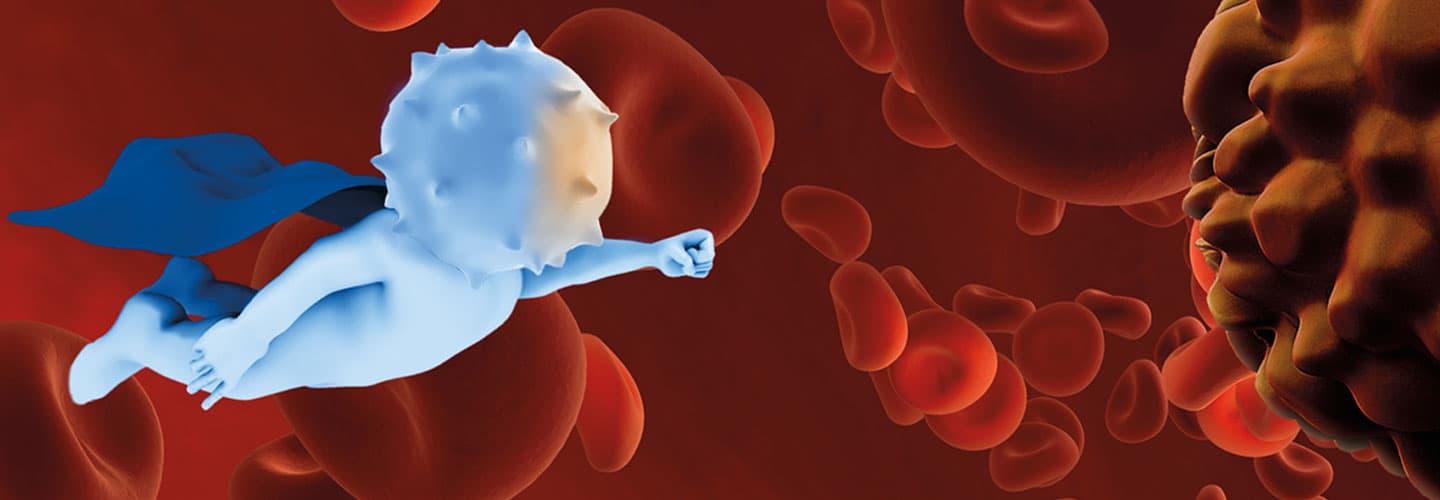Immunotherapy: Using the body's immune system to fight cancer

Therapies that use the body’s immune system are revolutionizing the way we treat cancer. The latest heroes in the battle against cancer are T cells, a type of white blood cell that is part of the immune system. And UChicago Medicine researchers are working to extend their powers.
“We are talking about diseases where we used to tell patients during their first clinic visit that they were going to die from cancer,” said medical oncologist Jason Luke, MD, who specializes in melanoma and advanced solid tumors.
“Now, more and more often, they find that they are not anywhere near dying,” Luke said. “It’s hard for people outside the field to grasp how significant and encouraging that is.”
This revolution in cancer treatment is driven by immunotherapy: Checkpoint inhibitors. Monoclonal antibodies. Cancer vaccines. And the newest superhero in this crusade against cancer, CAR T-cell therapy for both children and adults with certain types of blood cancers. Some of these advances are built on discoveries made at the University of Chicago.
“When (immunotherapy) works, it works,” Luke said. For most cancers, the response rate is about 20 percent, but the patients who do respond to immunotherapy, do really well, he said. “We’re beginning to see patients from early clinical trials — those who started therapy four or five years ago and have been off treatment for a year or more — without a recurrence.”
The challenge now is learning how to extend the benefits of immune-based therapies to more patients.
How it works: Checkpoint Inhibitors
Cancer immunotherapy, like diplomacy, is about opening doors and crossing boundaries. The core problem has been enabling each patient’s internal anti-cancer tools, especially specific sets of T cells, to slip over the border and into the tumor.
The key point is that, in immunotherapy, the drug is not your treatment — your body’s T cells are the treatment.The immune system should be able to get rid of any aberrant, hyper-proliferative cells without much trouble. But tumors, like a James Bond movie villain, seem to have their own malignant ideas, as well as sophisticated biotechnology. They can lock the doors, limit access, throw up roadblocks.
The primary obstacle, known as a “checkpoint,” even has a Bond-like name — programmed cell death protein 1 (PD-1). This cell-surface receptor is found on T cells, one of the body’s primary anti-cancer warriors. PD-1 is one part of a two-piece “off switch” that can calm down an overactive or misdirected immune response, preventing autoimmune diseases. It helps keep T cells from attacking other cells in the body.
When PD-1 on T cells connects with its frequent partner — programmed cell death ligand 1 (PD-L1), found on normal as well as cancer cells — the contact, not unlike a handshake, instructs the T cell to back off and leave the other cells alone. Tumors evade the immune system by exhibiting volumes of PD-L1.
One type of immunotherapy uses monoclonal antibodies that target either PD-1 or PD-L1 to block this interaction. This can open the gates for T cells, restoring the desired immune response against cancer cells. These drugs have shown a great deal of promise for many types of cancer.
Checkpoint inhibitors don’t directly treat the disease; they help the patient’s immune system fight the disease. “The key point is that, in immunotherapy, the drug is not your treatment — your body’s T cells are the treatment,” said medical oncologist CAR (chimeric antigen receptor) T-cell therapy, the treatment supercharges a patient’s white blood cells to seek out and destroy cancer cells.
UChicago Medicine was the first institution in the country to offer the FDA-approved treatment for both children and adults.
The term chimera, from Greek mythology, suggests a fearsome, fire-breathing monster cobbled together from a lion’s head, a goat’s body, and a dragon’s (or serpent’s) tail. When applied to cellular therapy, the components are simplified and miniaturized.
The patient’s own T cells are collected through a non-invasive process similar to blood donation. Scientists in a laboratory insert an antibody-like protein (CAR), which serves as the lion. It can recognize a specific cancer-related antigen on a cell’s surface and kill that cell. The goat and the serpent connect the receptor construct to the newly weaponized T cell.The CAR T cells multiply in the lab until they number in the millions. The cells are frozen and sent back to the patient’s hospital, where they are returned to the patient’s bloodstream.
How does CAR T-cell therapy work?
The modified T cells search and destroy specific cells. At this time, most CAR T cells are designed to find cells that display a surface protein called CD19, which is found on all B lymphocytes. When these modified T cells detect and connect with these cells, normal or cancerous, they annihilate them.
UChicago Medicine was the first institution in the country to offer the FDA-approved treatment for both children and adults.
“CAR T is the first truly effective immune therapy for a human cancer,” said

CAR T-Cell Therapy
CAR T-cell therapy supercharges a patient's white blood cells to find and destroy cancer cells. UChicago Medicine research played a key role in the development of this exciting new immunotherapy.
View videos and learn more
Cancer Immunotherapy
Immunotherapy refers to a medical treatment that turns the power of the immune system against disease. Cancer immunotherapy acts on the cells of the immune system to seek out, recognize and attack cancer.
Learn about immunotherapy options to treat cancer
